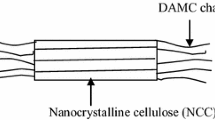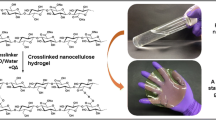Abstract
We produced novel nanocellulose particles made from cellulose fibers by periodate oxidation. For partial oxidation [degree of substitution (DS) <2], three products were generated after the periodate oxidized fibers were heat treated: fibrous cellulose, rod-like dialdehyde cellulose (DAC) nanofibers which we refer to as sterically stabilized nanocrystalline cellulose (SNCC), and dissolved DAC which is a copolymer of cellulose and DAC which we refer to as dialdehyde modified cellulose (DAMC). The products were separated by centrifugation and cosolvent addition. SNCC has similar dimension (100–200 nm in length and 5–8 nm in width) as conventional nanocrystalline cellulose (NCC) made by sulfuric acid hydrolysis. Several techniques were applied to characterize SNCC and its properties are compared to NCC. DAMC was found to be soluble in hot water or a few solvents (such as dimethyl formamide and dimethyl acetamide) at elevated temperature, but was insoluble in most common solvents at room temperature. The molecular weight of DAC (DS = 2) produced under various conditions (heating time and temperature) was determined by gel permeation chromatography. It was shown that the molecular weight decreased from 85.1 to 4.1 kDa with heating time and residence time when cooled down to room temperature.









Similar content being viewed by others
References
Atalla RH, VanderHart DL (1999) The role of solid state C-13 NMR spectroscopy in studies of the nature of native celluloses. Solid-State Nucl Magn Reson 15:1–19
Beck-Candanedo S, Roman M, Gray DG (2005) Effect of reaction conditions on the properties and behavior of wood cellulose nanocrystal suspensions. Biomacromolecules 6(2):1048–1054
Bhattacharyya D, Hestekin JA, Brushaber P, Cullen L, Bachas LG, Sikdar SK (1998) Novel poly-glutamic acid functionalized microfiltration membranes for sorption of heavy metals at high capacity. J Membr Sci 141:21–135
Casu B, Naggi A, Torri G, Allegra G, Meille SV, Cosani A, Terbojevich M (1985) Stereoregular acyclic polyalcohols and polyacetates from cellulose and amylase. Macromolecules 18:2762–2767
Cranston ED, Gray DG (2006) Morphological and optical characterization of polyelectrolyte multilayers incorporating nanocrystalline cellulose. Biomacromolecules 7(9):2522–2530
Dong XM, Kimura T, Revol JF, Gray DG (1996) Effects of ionic strength on the isotropic–chiral nematic phase transition of suspensions of cellulose crystallites. Langmuir 12:2076–2082
Fleer GJ, Cohen Stuart MA, Scheutjens JMHM, Cosgrove T, Vincent B (1993) Polymers at interfaces. Chapman and Hall, London, p 10
Fukuzumi H, Saito T, Iwata T, Kumamoto Y, Isogai A (2009) Transparent and high gas barrier films of cellulose nanofibers prepared by TEMPO-mediated oxidation. Biomacromolecules 10(1):162–165
Gal’braikh LS, Rogovin ZA (1971) Cellulose and cellulose derivatives. In: Bikales NM, Segal L (eds), vol V, Part V. Wiley Interscience, New York, pp 893–894
Henriksson M, Henriksson G, Berglund LA, Lindström T (2007) An environmentally friendly method for enzyme-assisted preparation of microfibrillated cellulose (MFC) nanofibers. Eur Polym J 43:3434–3441
Herrick FW, Casebier RL, Hamilton JK, Sandberg KR (1983) Microfibrillated cellulose: morphology and accessibility. J Appl Polym Sci Appl Polym Symp 37:797–813
Isogai A (2013) Wood nanocelluloses: fundamentals and applications as new bio-based nanomaterials. J Wood Sci 59(6):449–459
Jowkarderis L, van de Ven TGM (2014) Intrinsic viscosity of aqueous suspensions of cellulose nanofibrils. Cellulose 21(4):2511–2517
Keshk SMAS (2008) Homogenous reactions of cellulose from different natural sources. Carbohydr Polym 74:942–945
Kim UJ, Kuga S, Wada M, Okano T, Kondo T (2000) Periodate oxidation of crystalline cellulose. Biomacromolecules 1(3):488–492
Kim UJ, Wada M, Kuga S (2004) Solubilization of dialdehyde cellulose by hot water. Carbohydr Polym 56:7–10
Klemn D, Heublein B, Fink HP, Bohn A (2005) Cellulose: fascinating biopolymer and sustainable raw material. Angew Chem Int Ed 44:3358–3393
Liimatainen H, Visanko M, Sirvio JA, Osmo EO, Hormi OEO, Niinimaki J (2012) Enhancement of the nanofibrillation of wood cellulose through sequential periodate–chlorite oxidation. Biomacromolecules 13(5):1592–1597
López-Rubio A, Lagaron JM, Ankerfors M, Lindström T, Nordqvist D, Mattozzi A, Hedenqvist MS (2007) Enhanced film forming and film properties of amylopectin using micro-fibrillated cellulose. Carbohydr Polym 68(4):718–727
Maekawa E, Koshijima T (1984) Properties of 2,3-dicarboxyl cellulose combined with various metallic ions. J Appl Polym Sci 29:2289–2297
Nakagaito AN, Yano H (2005) Novel high-strength biocomposites based on microfibrillated cellulose having nano-order-unit web-like network structure. Appl Phys A Mater Sci Process 80:155–159
Napper DH (1984) Polymeric stabilization of colloidal dispersions, chapter 5. Academic Press, London
Pääkkö M, Ankerfors M, Kosonen H, Nykanen A, Ahola S, Osterberg M, Ruokolainen J, Laine J, Larsson PT, Ikkala O, Lindström T (2007) Enzymatic hydrolysis combined with mechanical shearing and high-pressure homogenization for nanoscale cellulose fibrils and strong gels. Biomacromolecules 8(6):1934–1941
Rajalaxmi D, Jiang N, Leslie G, Ragauskas AJ (2010) Synthesis of novel water-soluble sulfonated cellulose. Carbohydr Res 345:284–290
Sabzalian Z (2012) Cross-linking and hydrophobization of chemically modified cellulose fibers. Dissertation, McGill University
Saito T, Nishiyama Y, Putaux JL, Vignon M, Isogai A (2006) Homogeneous suspensions of individualized microfibrils from TEMPO-catalyzed oxidation of native cellulose. Biomacromolecules 7(6):1687–1691
Somerville C, Bauer S, Brininstool G, Facette M, Hamann T, Milne J, Osborne E, Paredez A, Persson S, Raab T, Vorwerk S, Youngs H (2004) Toward a systems approach to understanding plant cell walls. Science 306:2206–2211
Svagan AJ, Samir MASA, Berglund LA (2007) Biomimetic polysaccharide nanocomposites of high cellulose content and high toughness. Biomacromolecules 8(8):2556–2563
Tejado A, Alam MN, Antal M, Yang H, van de Ven TGM (2012) Energy requirements for the disintegration of cellulose fibers into cellulose nanofibers. Cellulose 19:831–842
van de Ven TGM (1989) Colloidal hydrodynamics. Academic Press, London, pp 222–227
VaVeelart S, Wit D, Gotlieb KF, Verhe R (1997) Chemical and physical transition of periodate oxidized potato starch in water. Carbohydr Polym 33:153–162
Visanko M, Liimatainen H, Sirviö J, Heiskanen J, Hormi O, Niinimäki J (2014) Amphiphilic cellulose nanocrystals from acid-free oxidative treatment: physico-chemical characteristics and use as an oil–water stabilizer. Biomacromolecules 15:2769–2775
Yang H, Tejado A, Alam MN, Antal M, van de Ven TGM (2012) Films prepared from electrosterically stabilized nanocrystalline cellulose. Langmuir 28:7834–7842
Yang H, Alam MN, van de Ven TGM (2013) Highly charged nanocrystalline cellulose and dicarboxylated cellulose from periodate and chlorite oxidized cellulose fibers. Cellulose 20(4):1865–1875
Acknowledgements
The authors would like to thank the Natural Science and Engineering Research Council of Canada (NSERC) for the funding of an industrial research chair cosponsored by FPInnovations and funding of the NSERC Strategic Research Network on Green Wood Fiber Products. Contributions from the FQRNT Centre for Self-Assembled Chemical Structures (CSACS) are also acknowledged.
Author information
Authors and Affiliations
Corresponding author
Rights and permissions
About this article
Cite this article
Yang, H., Chen, D. & van de Ven, T.G.M. Preparation and characterization of sterically stabilized nanocrystalline cellulose obtained by periodate oxidation of cellulose fibers. Cellulose 22, 1743–1752 (2015). https://doi.org/10.1007/s10570-015-0584-4
Received:
Accepted:
Published:
Issue Date:
DOI: https://doi.org/10.1007/s10570-015-0584-4




